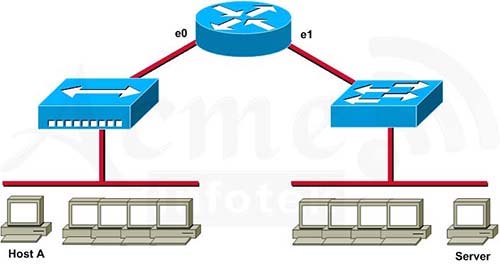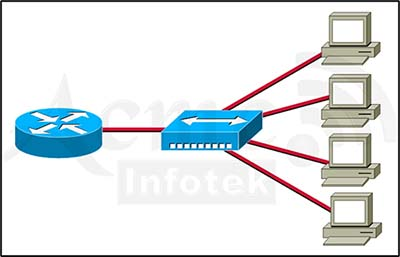Cisco® 200-125 Exam Practice Questions (P. 1)
- Full Access (1926 questions)
- One Year of Premium Access
- Access to one million comments
- Seamless ChatGPT Integration
- Ability to download PDF files
- Anki Flashcard files for revision
- No Captcha & No AdSense
- Advanced Exam Configuration
Question #1
A network interface port has collision detection and carrier sensing enabled on a shared twisted pair network. From this statement, what is known about the network interface port?
- AThis is a 10 Mb/s switch port.
- BThis is a 100 Mb/s switch port.
- CThis is an Ethernet port operating at half duplex.
- DThis is an Ethernet port operating at full duplex.
- EThis is a port on a network interface card in a PC.
Correct Answer:
C
The only time that CSMA/CD (carrier sense medium access with collision detection) is ever needed is when the medium is shared by all devices. In this situation, devices can never send and receive at the same time; they must operate in half-duplex mode. The bitrate is irrelevant.
C
The only time that CSMA/CD (carrier sense medium access with collision detection) is ever needed is when the medium is shared by all devices. In this situation, devices can never send and receive at the same time; they must operate in half-duplex mode. The bitrate is irrelevant.
send
light_mode
delete
Question #2
A receiving host computes the checksum on a frame and determines that the frame is damaged. The frame is then discarded. At which OSI layer did this happen?
- Aphysical
- Bsession
- Cdata link
- Dtransport
- Enetwork
Correct Answer:
C
Operations on frames occur at the data link layer.
C
Operations on frames occur at the data link layer.
send
light_mode
delete
Question #3
Refer to the graphic.

Host A is communicating with the server. What will be the source MAC address of the frames received by Host A from the server?

Host A is communicating with the server. What will be the source MAC address of the frames received by Host A from the server?
- Athe MAC address of the server network interface
- Bthe MAC address of host A
- Cthe MAC address of router interface e1
- Dthe MAC address of router interface e0
Correct Answer:
D
Host A and the Server are on different subnets and are separated by routers, so the MAC address of the Server will never get back to Host A: the router will decapsulate the frames that the Server sends. The router will re-encapsulate the packets from the Server and and put its own MAC address on the outbound interface (e0) in the frames. Host A will see the MAC address of router interface e0.
D
Host A and the Server are on different subnets and are separated by routers, so the MAC address of the Server will never get back to Host A: the router will decapsulate the frames that the Server sends. The router will re-encapsulate the packets from the Server and and put its own MAC address on the outbound interface (e0) in the frames. Host A will see the MAC address of router interface e0.
send
light_mode
delete
Question #4
Refer to the exhibit.
What two results would occur if the hub were to be replaced with a switch that is configured with one Ethernet VLAN? (Choose two.)

What two results would occur if the hub were to be replaced with a switch that is configured with one Ethernet VLAN? (Choose two.)

- AThe number of broadcast domains would remain the same.
- BThe number of collision domains would increase.
- CThe number of collision domains would decrease.
- DThe number of broadcast domains would decrease.
- EThe number of collision domains would remain the same.
- FThe number of broadcast domains would increase.
Correct Answer:
AB
Only routers create broadcast domains, so the number of broadcast domains will be unchanged. A hub is a single collision domain, whereas each port on a switch is its own collision domain. Therefore, by adding a switch the number of collision domains will increase.
AB
Only routers create broadcast domains, so the number of broadcast domains will be unchanged. A hub is a single collision domain, whereas each port on a switch is its own collision domain. Therefore, by adding a switch the number of collision domains will increase.
send
light_mode
delete
Question #5
What is the first 24 bits in a MAC address called?
send
light_mode
delete
Question #6
Refer to the exhibit. What type of connection would be supported by the cable diagram shown?


- APC to router
- BPC to switch
- Cserver to router
- Drouter to router
Correct Answer:
B
From the "Pin" and "Color" in the exhibit we know that this is a straight-through cable so it can be used to connect PC to switch.
B
From the "Pin" and "Color" in the exhibit we know that this is a straight-through cable so it can be used to connect PC to switch.
send
light_mode
delete
Question #7
What functions do routers perform in a network? (Choose two)
- Apacket switching
- Baccess layer security
- Cpath selection
- DVLAN membership assignment
- Ebridging between LAN segments
- Fmicrosegmentation of broadcast domains
Correct Answer:
AC
AC
send
light_mode
delete
Question #8
A network administrator is verifying the configuration of a newly installed host by establishing an FTP connection to a remote server.
What is the highest layer of the protocol stack that the network administrator is using for this operation?
What is the highest layer of the protocol stack that the network administrator is using for this operation?
- Aapplication
- Bpresentation
- Csession
- Dtransport
- Einternet
- Fdata link
Correct Answer:
A
FTP is an application layer protocol, so this is the highest OSI layer involved in the operation.
A
FTP is an application layer protocol, so this is the highest OSI layer involved in the operation.
send
light_mode
delete
Question #9
Which statement describes the process of dynamically assigning IP addresses by the DHCP server?
- AAddresses are allocated after a negotiation between the server and the host to determine the length of the agreement.
- BAddresses are permanently assigned so that the hosts uses the same address at all times.
- CAddresses are assigned for a fixed period of time, at the end of the period, a new request for an address must be made.
- DAddresses are leased to hosts, which periodically contact the DHCP server to renew the lease.
Correct Answer:
D
D
send
light_mode
delete
Question #10
How does a DHCP server dynamically assign IP addresses to hosts?
- AAddresses are allocated after a negotiation between the server and the host to determine the length of the agreement.
- BAddresses are permanently assigned so that the hosts uses the same address at all times.
- CAddresses are assigned for a fixed period of time, at the end of the period, a new request for an address must be made.
- DAddresses are leased to hosts. A host will usually keep the same address by periodically contacting the DHCP server to renew the lease.
Correct Answer:
D
D
send
light_mode
delete
All Pages
